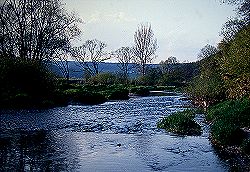Ponor
A ponor is an opening at which a surface water body, stream, river or lake disappears from the earth’s surface to flow underground.

 Donauversickerung, Germany.
Donauversickerung, Germany.
 Rakov National Park, Slowenia.
Rakov National Park, Slowenia.
 Gaping Ghyll with water flowing in. North Yorkshire, England. Public Domain.
Gaping Ghyll with water flowing in. North Yorkshire, England. Public Domain.
A ponor is the counterpart to the karst spring, and like the latter there are many different forms. The word ponor is more or less a general term and generally refers to a place where water disappears. The word comes from the classic Karst, where such places were known for a long time. It is still used today in Slovenian, Croatian and other South Slavic languages. However, there are two different types of ponors:
- If the ponor cannot fully absorb the water, it absorbs part of the water, but the river continues to flow, albeit with less water. Karst lakes, which are lakes without an outflow, are drained this way. The ponor is located underwater, and it is only noticeable by a decrease in water or probably by an eddy on the surface.
- If the ponor can completely absorb the water, the water is not accumulating on the surface. In other words, a stream or river disappears completely, hence the name loosing stream is used.
This distinction depends entirely on the relationship between the inflow volume and the flow capacity of the cave system. Obviously, a cave passage has a certain cross-section that changes only very slowly and limits the amount of water that can flow through it. In contrast, surface waters are highly variable in their flow. There are seasonal changes, snow-melt and heavy rainfall, which greatly alter the volume of water. In other words, most ponors are both types, depending on the weather and the resulting inflow volume.
Over the years, a variety of terms have been used for ponors, especially as this term was introduced in geology only a few decades ago. This complicates things somewhat. For example, there are sink, sinkhole, river sink, loosing stream, swallow hole, and gully. Most names do not tell much about the ponor, only the terms river sink or loosing stream implicate that the whole river goes underground, which is the second type ponors described above. We generally use the generic term ponor on showcaves.com. In some cases we use loosing stream if the river actually vanishes completely all the year independent of its size.
And there is a quite dangerous term, which is unfortunately used for ponors in English literature: sinkhole or sink hole. This term is well-defined in geology and karstology, and it means a depression which was formed by the collapse of a cave below. The sink means that the rocks were sinking down due to the collapse. While dolines are often ponors, which includes collapse dolines aka sinkholes, the name is already in use. So ponors as well as sinks are not sinkholes!
This mere description is one thing, but what is much more interesting is how such ponors come about in the first place. Or to put it another way: a karst area is characterized by underground drainage, so why does water flow above ground here? As always, there are several answers.
- The first and most important is contact karst, which means that a rock which is not soluble and therefore not karstified is bordering to limestone which is karstified. As soon as the river flowing above ground reaches the karst, it disappears underground. A spectacular example is Gaping Ghyll in Great Britain.
- Another typical scenario are so-called polje, which are geological features that are formed by tectonics, causing small regions in the karst to drain above ground. The water appears at one end in a resurgence or river cave and disappears at the other end in ponors or in a river cave. These polje are typical in the Dinaric Karst, hence the name, but they can be found all over the world.
- Another form of ponors are simply connections between a cave system or the groundwater and the surface, in connection with the rise and fall of the karst groundwater level. As a rule, these openings are more or less invisible because they are filled with loose debris. This is of course no obstacle for the water. One typical result is karst lakes, another is rivers such as the Lone river in southern Germany. If the karst water level is high, hollow forms fill with water; if the karst water level sinks, the water flows out through ponors.
- Then, there are a number of valleys that are dry valleys under normal conditions. However, they are reactivated during particularly high rainfall or when the snow melts. A stream then flows through the dry valley again, at least as far as a ponor where it then disappears underground.
- Clay soil or frozen ground can also prevent the water from penetrating directly into the cracks in the ground. It then flows for a while on the surface until it finds an unblocked crevice in the ground, which then becomes a ponor for a short time. If this happens frequently, for example seasonally, a small streambed can even form that leads to the ponor and is dry for most of the year.
These are various scenarios that lead to the formation of ponors, probably the most common, but certainly not all.
- See also
 Donauversickerung, Germany
Donauversickerung, Germany Gaping Ghyll, England
Gaping Ghyll, England Sinks Canyon State Park, U.S.A.
Sinks Canyon State Park, U.S.A. The Pernod Accident, France
The Pernod Accident, France Planinko polje, Slovenia
Planinko polje, Slovenia
 Search DuckDuckGo for "Ponor"
Search DuckDuckGo for "Ponor" Ponor - Wikipedia (visited: 23-FEB-2025)
Ponor - Wikipedia (visited: 23-FEB-2025)
 Index
Index Topics
Topics Hierarchical
Hierarchical Countries
Countries Maps
Maps